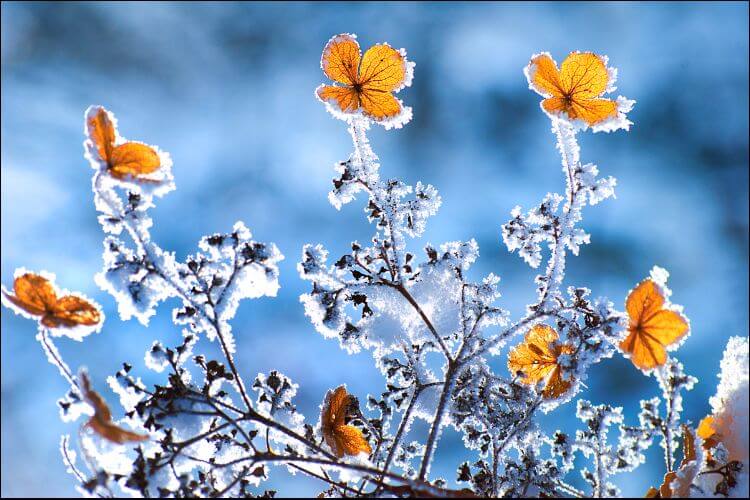Are you worried about how to keep your beloved annuals alive through the harsh winter months? Don’t fret! With the right knowledge and preparation, you can ensure the survival of your plants and enjoy their vibrant beauty year after year.
In this article, we will guide you through the essential steps to protect your annuals from the freezing temperatures and ensure their safety. You’ll learn about understanding the frost tolerance of your plants, providing proper insulation and protection, mulching around the base of the plants, watering appropriately, and even bringing potted annuals indoors.
We’ll also discuss the importance of pruning and cleaning up the plants, monitoring for pests and diseases, and planning ahead for the spring season. By following these tips, you can create a safe environment for your annuals to thrive and bloom, even in the coldest of winters.
So let’s get started and keep your annuals alive through winter!
Quick Summary
- Winter care is crucial for the survival and future blooming of annuals.
- Different annuals have varying levels of frost tolerance, with pansies and snapdragons being more cold-resistant.
- Proper preparation before the first frost, including watering, mulching, and removing dead foliage, is important.
- Providing insulation and shelter through mulching, protective coverings, or temporary structures is essential for the survival of annuals during winter.
Understand the Frost Tolerance of Your Annuals
You’ll be amazed at how resilient your annuals can be when you understand just how tough they are against the freezing cold. Winter care for your annuals is essential if you want them to survive the cold weather and thrive again come spring. Understanding the frost tolerance of your annuals is the first step to ensuring their survival.
Some annuals are more cold-hardy than others. Before winter sets in, it’s important to know which ones can withstand the freezing temperatures and which ones need extra protection. Plants like pansies, snapdragons, and kale are known for their cold weather survival. These hardy annuals can tolerate frost and even continue to bloom throughout the winter months.
On the other hand, tender annuals like impatiens and begonias are not frost-tolerant and need to be protected from freezing temperatures. Consider moving them indoors or covering them with a frost cloth to provide some insulation.
When it comes to winter care, it’s also important to prepare your annuals before the first frost. Make sure they’re well-watered and adequately mulched to protect their root systems. Removing any dead or diseased foliage will also help prevent the spread of diseases during the winter months.
By understanding the frost tolerance of your annuals and providing them with the necessary winter care, you can ensure their survival and enjoy their vibrant blooms again in the spring. Stay proactive and keep your annuals safe during the cold winter months.
Provide Proper Insulation and Protection
To successfully protect your beloved annuals during the winter season, it’s crucial to provide them with adequate insulation and shelter. Winterizing techniques and cold weather care are essential to ensure the survival of your plants.
One of the most effective ways to provide insulation is by using mulch. Adding a thick layer of mulch around the base of your annuals will help retain heat and keep the soil temperature stable. Additionally, you can use protective coverings such as burlap or frost blankets to shield your plants from harsh winds and freezing temperatures.
When applying mulch, make sure to cover the entire root zone of your annuals, extending a few inches beyond the outermost leaves. This will provide maximum insulation for the roots, which are particularly vulnerable to cold temperatures. It’s also important to water your annuals adequately before the first frost. Moist soil retains heat better than dry soil, so watering before winter sets in will help provide extra protection.
In addition to insulation, providing physical shelter for your annuals can greatly increase their chances of survival. Consider setting up temporary structures like cold frames or hoop houses to shield your plants from extreme weather conditions. These structures can be made from simple materials like PVC pipes and plastic sheeting, offering a protective barrier against freezing temperatures.
By following these winterizing techniques and providing proper insulation and shelter, you can ensure the survival of your annuals throughout the cold winter months. Remember, taking the necessary precautions will help keep your plants safe and thriving until spring arrives.
Mulch Around the Base of the Plants
Create a cozy protective barrier for your plants by surrounding their base with a thick layer of mulch, ensuring they stay snug and warm during the chilly winter months. Winter protection is crucial for the survival of your annuals, and mulching is a simple yet effective method to provide that much-needed insulation.
By adding a layer of mulch around the base of your plants, you create a buffer that helps regulate soil temperature and prevents extreme fluctuations that can harm delicate roots. Mulching also acts as a protective shield, shielding your plants from harsh winter conditions. It acts as a barrier against strong winds that can dry out or damage the foliage. Additionally, mulch helps to retain moisture, reducing the risk of dehydration during dry spells or when the ground freezes. This is especially important for annuals, as they have shallow root systems that are more susceptible to damage.
To properly mulch your plants, start by clearing away any debris or weeds from the base. Then, apply a layer of mulch around 2-4 inches thick, making sure to leave some space around the stem to prevent rot. Use organic mulch such as shredded leaves, straw, or wood chips for best results. Remember to replenish the mulch as needed throughout the winter to maintain its protective benefits.
By mulching around the base of your annuals, you provide them with the necessary winter protection and ensure their survival. So, take the extra step to care for your plants and create a cozy sanctuary for them during the colder months.
Water Appropriately
Ensure that your plants receive the right amount of water during the winter months to maintain their health and vitality. Proper watering is essential for the survival of annuals through the colder season.
While it may be tempting to neglect watering during winter, it’s crucial to provide adequate moisture to prevent dehydration and root damage. Here are some winter watering techniques to help keep your annuals alive.
Firstly, monitor the moisture levels of the soil regularly. Although plants may not require as much water as they do in the summer, the soil shouldn’t be allowed to completely dry out. Water the plants when the top inch of soil feels dry to the touch. Be careful not to overwater, as this can lead to root rot and other fungal diseases.
Secondly, water during the warmest part of the day. This allows the water to soak into the soil before the temperatures drop at night, reducing the risk of freezing roots. Watering in the morning also helps prevent excess moisture from sitting on the leaves overnight, which can lead to fungal issues.
Lastly, consider using a soaker hose or drip irrigation system to water your plants more efficiently. These methods deliver water directly to the plant’s root zone, minimizing water loss through evaporation.
By following these proper watering techniques during the winter months, you can ensure the health and vitality of your annuals, helping them survive until spring arrives.
Consider Bringing Potted Annuals Indoors
Consider bringing your potted annuals indoors for a vibrant burst of color during the colder months. Overwintering techniques can help you keep your annuals alive and thriving until spring arrives.
Indoor gardening provides a safe environment for your plants, protecting them from the harsh winter conditions that can often be fatal. When bringing your potted annuals indoors, it’s essential to prepare them properly. Start by inspecting the plants for any signs of pests or diseases. Remove any dead or damaged foliage, and trim the plants to a manageable size. Before bringing them inside, give them a thorough watering to ensure they’re well hydrated.
Find a suitable location in your home where your potted annuals can receive adequate sunlight. South-facing windows are ideal, as they provide the most light. If natural light is limited, consider using artificial grow lights to supplement.
Maintain a consistent temperature and humidity level for your indoor annuals. Keep the temperature between 60-70°F (15-21°C) during the day and slightly cooler at night. Use a humidifier or place a tray of water near the plants to increase humidity levels.
Continue to monitor your potted annuals closely for any signs of stress or disease. Adjust watering and care accordingly to ensure their well-being. With proper overwintering techniques and indoor gardening, you can enjoy the beauty of your annuals all year round.
Can the Solutions for a Mud-Free Backyard Also Help Protect Annuals in Winter?
Looking for solutions for mud in backyard? Well, guess what, these solutions can also double up to protect your delicate annuals during the winter. By adding proper drainage and introducing materials like gravel or mulch, you can prevent mud buildup and create an insulating layer that shields your plants from harsh winter conditions. So, implement these solutions to keep your backyard mud-free while ensuring the safety of your annuals throughout the winter season.
Prune and Clean Up the Plants
Spruce up your plants by pruning and cleaning them, and watch as they thrive in your indoor garden during the colder months. Proper pruning techniques are essential for winter plant care. By removing any dead or diseased branches, you can prevent the spread of pests and diseases. Use clean, sharp pruning shears to make clean cuts, and always cut just above a healthy bud or node. Additionally, thin out any overcrowded areas to improve air circulation and reduce the risk of fungal growth.
Cleaning your plants is equally important. Dust and debris can accumulate on the leaves, blocking sunlight and hindering photosynthesis. Gently wipe the leaves with a damp cloth or use a soft brush to remove any build-up. This will not only keep your plants looking fresh but also help them absorb more light.
To give you a better idea of when to prune and clean specific types of annuals, refer to the table below:
| Plant Type | Pruning Time | Cleaning Frequency |
|---|---|---|
| Petunias | Early spring | Once a month |
| Geraniums | Late winter | Every two weeks |
| Marigolds | Early fall | Once a month |
| Impatiens | Late summer | Every two weeks |
| Pansies | Early winter | Once a month |
Remember, a clean and well-pruned indoor garden is not only visually appealing but also promotes healthier growth and prevents potential problems. So, invest some time in pruning and cleaning your plants, and enjoy their beauty throughout the winter season.
Monitor for Pests and Diseases
Now that you’ve pruned and cleaned up your annual plants, it’s important to stay vigilant and monitor them for pests and diseases. Pest control and disease prevention are crucial for keeping your plants healthy and thriving through the winter months.
Start by regularly inspecting your plants for any signs of pests such as aphids, mites, or caterpillars. Look for chewed leaves, yellowing foliage, or sticky residue, as these are all indicators of an infestation. If you spot any pests, remove them by hand or use insecticidal soap, making sure to follow the instructions carefully.
In addition to pests, keep an eye out for any signs of diseases like powdery mildew or leaf spot. These can spread quickly and weaken your plants. To prevent diseases, make sure your plants have adequate air circulation by spacing them properly. Avoid overhead watering, as this can create a moist environment that encourages disease growth.
By staying proactive and addressing any pest or disease issues promptly, you’ll be able to protect your annuals and increase their chances of surviving the winter. Remember, prevention is key when it comes to keeping your plants safe and healthy.
Prepare for Spring by Planning Ahead
Get a head start on your spring garden by mapping out your planting beds and researching the best varieties of annuals to brighten up your yard. Winter gardening requires proper planning and preparation to ensure the survival of your plants. Overwintering plants involves protecting them from the harsh winter conditions and ensuring they have the necessary nutrients to survive until spring.
To successfully overwinter your annuals, it is important to understand their specific needs and requirements. Some annuals may be more cold-tolerant than others, so it is crucial to choose the right varieties for your region. Before the first frost hits, make sure to remove any dead or diseased plants to prevent the spread of pests and diseases.
When planning for spring, consider creating a planting schedule to help you stay organized. This will ensure that you have a constant supply of blooming annuals throughout the season. Additionally, consider using a 2 column and 4 row table to map out your planting beds. In the left column, list the different varieties of annuals you plan to grow, and in the right column, note the specific planting dates and any special care instructions.
By planning ahead, you can ensure a successful transition from winter to spring and enjoy a vibrant and colorful garden. Keep in mind the importance of monitoring for pests and diseases throughout the winter months to protect your plants and maintain a healthy garden.
Frequently Asked Questions
Can I leave my annuals outside during the winter without any protection?
No, you should not leave your annuals outside during the winter without any protection. Winter care is important for protecting annuals and ensuring their survival. Take steps to provide the necessary protection for your plants.
How often should I water my annuals during the winter?
During winter, water your annuals sparingly, as they require less moisture. Overwatering risks include root rot and fungal diseases. Be cautious not to drown your plants, as they need a balance of moisture to survive the cold season.
What are some common pests and diseases that affect annuals during the winter?
During winter, common pests that can harm your annuals include aphids, spider mites, and mealybugs. Some common diseases to watch out for are powdery mildew, gray mold, and root rot. Protect your plants from these threats to ensure their survival.
How do I properly clean up and prune my annuals before winter?
To properly clean up and prune your annuals before winter, use safe cleaning techniques and pruning tools. This ensures a healthy and safe environment for your plants. Remember to remove any dead or diseased parts to prevent the spread of pests and diseases.
What are some tips for planning ahead and preparing my annuals for spring?
To plan ahead and prepare your annuals for spring, use these planning strategies. Start by selecting the necessary supplies such as pots, soil, and fertilizers. This will help ensure a successful and safe transition for your plants.
Conclusion
In conclusion, you’ve learned some essential tips to keep your annuals alive through winter. By understanding their frost tolerance and providing insulation, mulching, and proper watering, you can ensure their survival.
Consider bringing potted annuals indoors and pruning them to maintain their health. Don’t forget to monitor for pests and diseases and plan ahead for spring. With these steps, you can enjoy beautiful and thriving annuals year after year.
So go ahead, put these tips into action and keep your garden vibrant and alive during the winter months.








